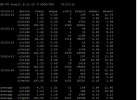anoobbhaskar
New Member
I am doing parallel dump in HP Unix system with open edge 10.1B running. My data base size is around 70 GB and System memory is 8 GB. The database is offline while performing the proutil dump with -RO option.
$DLC/bin/proutil $DUMPDB/ttgres -C dump cabininv $DCABININV -RO
The current issue is Disk IO become 100% when we start executing the Dump process. We are using CX4120 storage with RAID 10 for storing the data.I have checked with the VEndor and they confirmed that there will not be any problem with the device. Memory is showing 55 % and CPU is around 25% during the dump time. I will be able to execute more scripts simultaneously if Disk IO is very less.
Can anyone suggests me how we can reduce the Disk IO?
View attachment 1011
$DLC/bin/proutil $DUMPDB/ttgres -C dump cabininv $DCABININV -RO
The current issue is Disk IO become 100% when we start executing the Dump process. We are using CX4120 storage with RAID 10 for storing the data.I have checked with the VEndor and they confirmed that there will not be any problem with the device. Memory is showing 55 % and CPU is around 25% during the dump time. I will be able to execute more scripts simultaneously if Disk IO is very less.
Can anyone suggests me how we can reduce the Disk IO?
View attachment 1011

